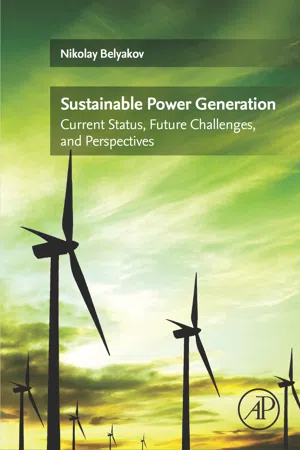

Sustainable Power Generation
Current Status, Future Challenges, and Perspectives
- 620 pages
- English
- ePUB (mobile friendly)
- Available on iOS & Android
About This Book
Sustainable Power Generation: Current Status, Future Challenges, and Perspectives addresses emerging problems faced by the transition to sustainable electricity generation and combines perspectives of engineering and economics to provide a well-rounded overview. This book features an in-depth discussion of the main aspects of sustainable energy and the infrastructure of existing technologies. It goes on to evaluate natural resources that are sustainable and convenient forms of energy, and finishes with an investigation of the environmental effects of energy systems and power generating systems of the future. Other sections tackle fundamental topics such as thermal power, nuclear energy, bioenergy, hydropower, challenges and risks to sustainable options, and emerging technologies that support global power trends.
Sustainable Power Generation explores the future of sustainable electricity generation, highlighting topics such as energy justice, emerging competences, and major transitions that need to be navigated. This is an ideal reference for researchers, engineers, and other technical specialists working in the energy sector, as well as environmental specialists and policy makers.
- Provides a multidisciplinary, structured approach to electricity generation, focusing on the key areas of technology, business, project management, and sustainability
- Includes analytics and discussions of sustainability metrics, underlying issues, and challenges
- Presents business cases, offering a mix of academic depth and practicality on energy options
Frequently asked questions
Information
Introduction
Overview
Concept of energy
Abstract
Keywords
1.1 What is energy
1.1.1 Concept of energy




1.1.2 Forms of energy
- • Potential energy reflects the potential (or possibility) of a system to have motion or to do work. This energy can have different nature and may be due to the position of the objects relative to others, stresses within the object, electric charge, etc.
- • Kinetic energy is determined by the movement of the object or the composite motion. It is usually defined as the work needed to accelerate an object of a given mass from the rest state to its current velocity. In classical mechanics this energy is proportional to the mass of the object and the square of velocity, i.e.,

Table of contents
- Cover image
- Title page
- Table of Contents
- Copyright
- Dedication
- About the author
- Preface
- Acronyms
- Part One: Introduction to energy and energy systems
- Introduction
- Chapter One: Concept of energy
- Chapter Two: Evaluation of energy resources
- Chapter Three: Energy system and basic electricity market
- Part Two: Sustainable energy and power generation
- Introduction
- Chapter Four: The system boundaries of sustainability
- Chapter Five: Sustainable energy development
- Chapter Six: Power system and the environment
- Part Three: Thermal power as a bridging technology towards sustainability
- Introduction
- Chapter Seven: Concept of a thermal power plant
- Chapter Eight: Efficient and clean combustion of fossil fuels within boiler island
- Chapter Nine: Power island and balance of plant
- Chapter Ten: Fossil energy economics and project lifecycle
- Part Four: Past, present, and future of sustainable nuclear power
- Introduction
- Chapter Eleven: Nuclear energy
- Chapter Twelve: Modern nuclear power plant
- Chapter Thirteen: Development of sustainable nuclear power plant project
- Part Five: Sustainable hydropower
- Introduction
- Chapter Fourteen: Traditional hydropower plant technology
- Chapter Fifteen: Hydropower project lifecycle
- Part Six: Emerging sustainable energy systems
- Introduction
- Chapter Sixteen: Wind energy
- Chapter Seventeen: Solar energy
- Chapter Eighteen: Energy from municipal solid waste
- Chapter Nineteen: Bioenergy
- Chapter Twenty: Geothermal energy
- Chapter Twenty-One: Ocean energy conversion
- Part Seven: Future of sustainable power generation
- Introduction
- Chapter Twenty-Two: Can we build a sustainable power generation system?
- Chapter Twenty-Three: Sustainable electricity management beyond generation
- Chapter Twenty-Four: Transitions towards a sustainable power generation system of the future
- Index